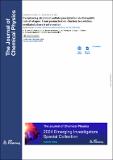Por favor, use este identificador para citar o enlazar a este item:
http://hdl.handle.net/10261/343197COMPARTIR / EXPORTAR:
 SHARE
BASE SHARE
BASE
|
|
| Visualizar otros formatos: MARC | Dublin Core | RDF | ORE | MODS | METS | DIDL | DATACITE | |

| Título: | Deciphering strontium sulfate precipitation via Ostwald's rule of stages: from prenucleation clusters to solution-mediated phase tranformation |
Autor: | Lauer, A. R.; Hellmann, R.; Montes-Hernandez, German; Findling, N.; Ling, W. L.; Epicier, T.; Fernandez-Martinez, A.; Van Driessche, Alexander E. S. | Palabras clave: | Crystallization Metastable phases Strontium compounds Sulfur compounds Supersaturation Aqueous species Biominerals Nucleation |
Fecha de publicación: | 2-feb-2023 | Editor: | American Institute of Physics | Citación: | Journal of Chemical Physics 158(5): 054501 (2023) | Resumen: | Multiple-step nucleation pathways have been observed during mineral formation in both inorganic and biomineral systems. These pathways can involve precursor aqueous species, amorphous intermediates, or metastable phases. Despite the widespread occurrence of these processes, elucidating the precise nucleation steps and the transformation mechanisms between each step remains a challenging task. Using a suite of potentiometric, microscopic, and spectroscopic tools, we studied the nucleation pathway of SrSO4 as a function of the physico-chemical solution parameters. Our observations reveal that below a threshold supersaturation, nucleation is driven by bound species, akin to the prenucleation cluster model, which directly leads to the formation of the stable phase celestine, SrSO4. At higher supersaturations, this situation is altered, with nucleation dominated by the consumption of free ions. Importantly, this change in nucleation mechanism is coupled to the formation of a hemihydrate metastable phase, SrSO4 · 1/2H2O, which eventually transforms into celestine, adhering to Ostwald's rule of stages. This transformation is a solution-mediated process, also occurring in the presence of a fluid film and is controlled by the physico-chemical parameters of the surrounding environment. It proceeds through the dissolution of the metastable phase and the de novo crystallization of the final phase. Overall, our results reveal that ion association taking place during the prenucleation stage dictates whether the nucleation pathway goes through an intermediate phase or not. This also underlines that although Ostwald's rule of stages is a common process, it is not a prerequisite for mineral formation - even in systems where it can occur. | Versión del editor: | http://dx.doi.org/10.1063/5.0136870 | URI: | http://hdl.handle.net/10261/343197 | Identificadores: | doi: 10.1063/5.0136870 issn: 1089-7690 |
| Aparece en las colecciones: | (IACT) Artículos |
Ficheros en este ítem:
| Fichero | Descripción | Tamaño | Formato | |
|---|---|---|---|---|
| 2023_JChemPhysics_158_54501.pdf | 11,66 MB | Adobe PDF |  Visualizar/Abrir |
CORE Recommender
Este item está licenciado bajo una Licencia Creative Commons

